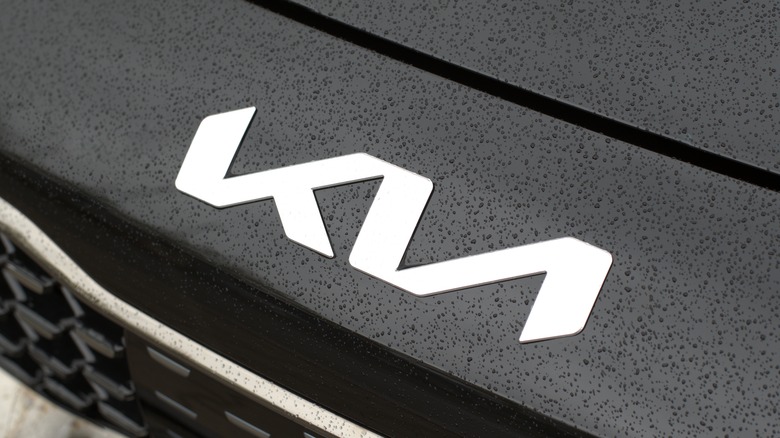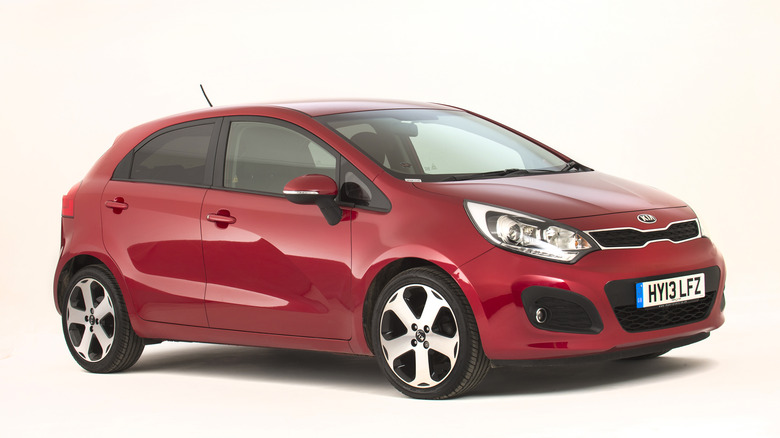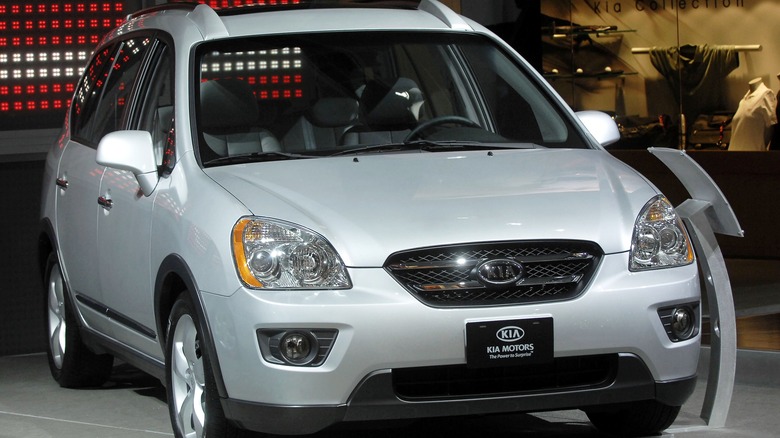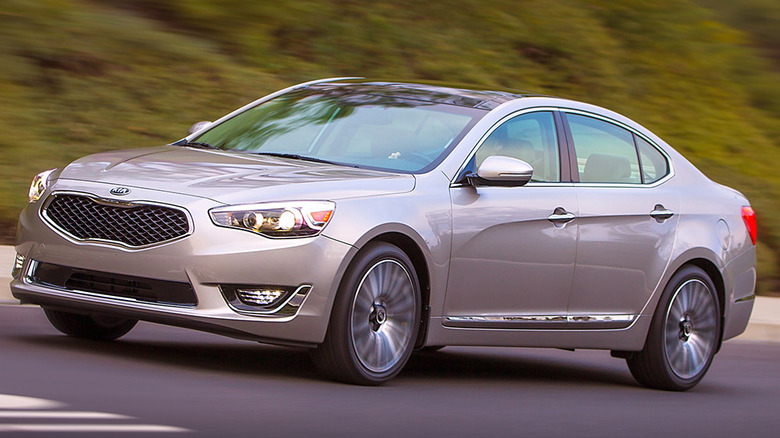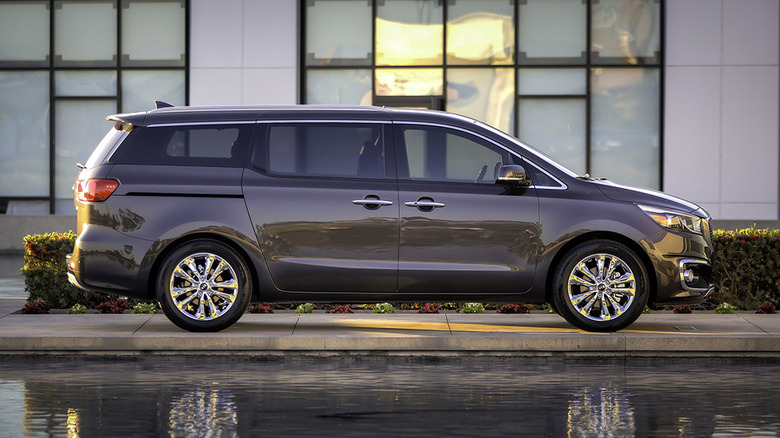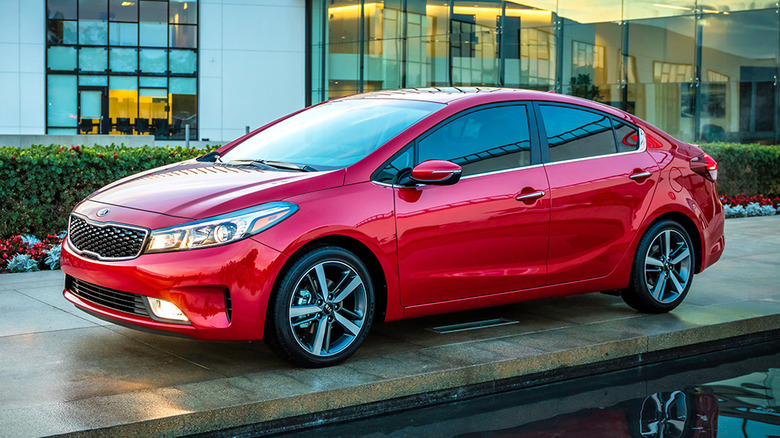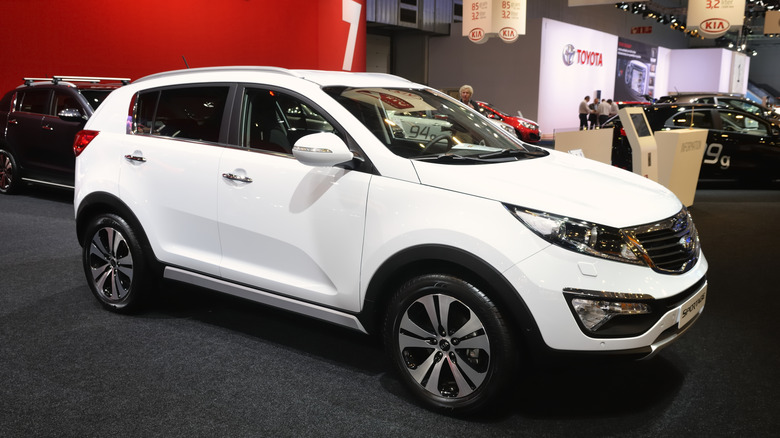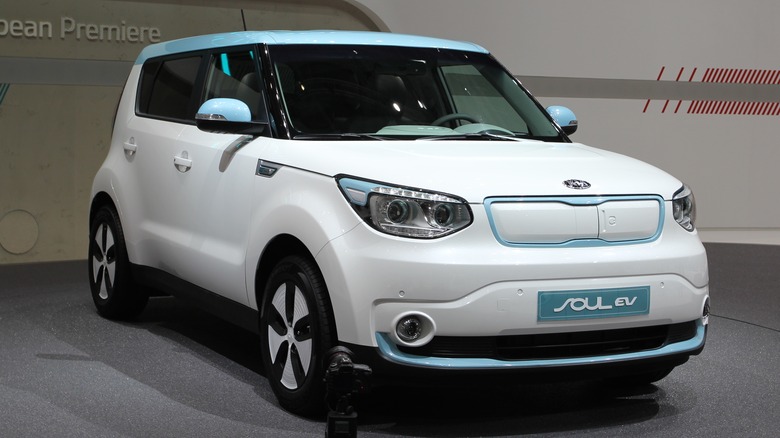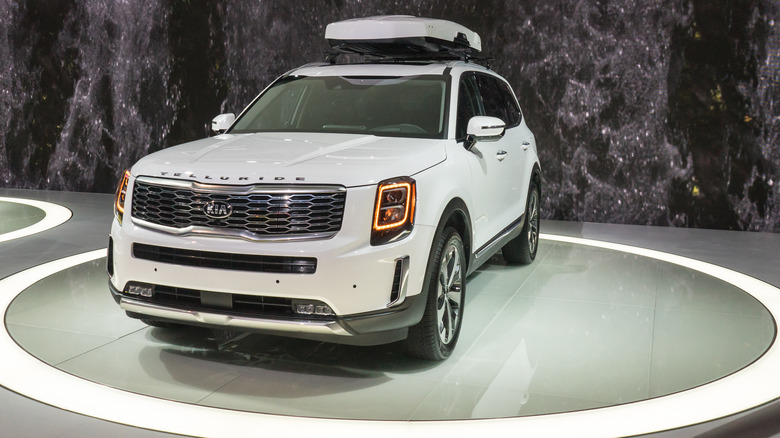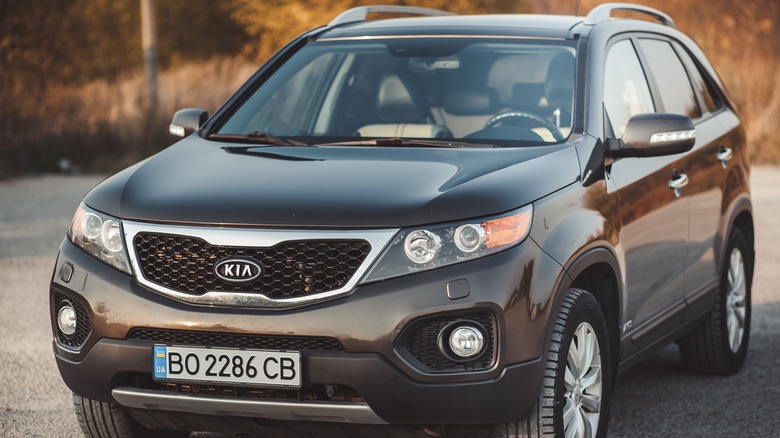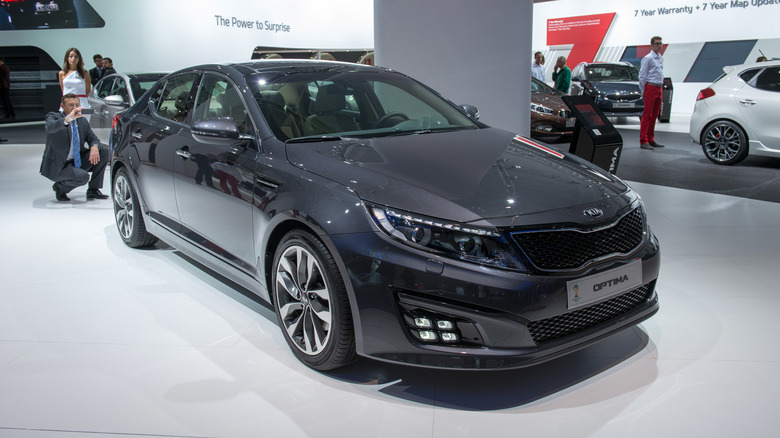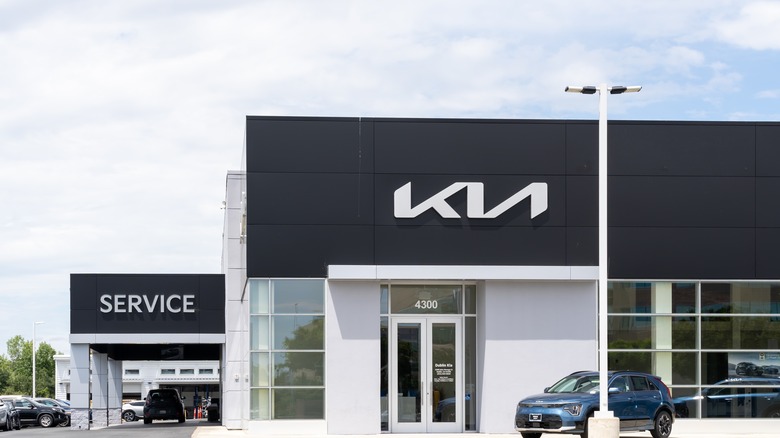10 Used Kia Models You Should Steer Clear Of At All Costs
For most folks in the market for a used car, a Kia can seem like an affordable and reliable option. After all, they've built a solid reputation over the past few decades and come with a handy 10-year/100,000-mile warranty whether you get one new or with some miles under its belt. We've previously ranked the most reliable Kia models, but in the same vein, not all Kia models will treat you the same down the line.
Some have proven to be more trouble than they're worth, even for casual drivers. You know the type — they break down more than your paycheck allows and constantly drain your bank account at the repair shop. The last thing anyone wants is a lemon lingering in the driveway or hogging up space in the garage. But before you take the plunge on a pre-owned Kia, it pays to do your homework on common issues and expected maintenance costs down the road. What seems like a decent deal on paper can end up being a financial albatross around your neck. This is especially important these days with used car prices through the roof.
We examined safety data from the National Highway Traffic Safety Agency (NHTSA) and consumer sources to cut through the marketing hype and get an honest view. We looked at recalls, reviews, and owner complaints for 10 Kia models and found that avoiding them was best. We also aimed to identify the most troublesome model year for each that presented the most issues.
11. 2013 Kia Rio
The most alarming issue with the 2013 Kia Rio is its significant engine problems, which have been widely reported on CarComplaints. From engine noise and failure to excessive oil consumption, owners have had to deal with costly repairs. Engine failure alone costs an average of $5,800 to replace, typically occurring around 107,5000 miles.
A bunch of owners also complain about their car's unbearable fuel consumption, likely far less than the advertised 31 mpg combined. Some also complain about fuel propulsion system issues which have led to reduced power and even stalling situations while on the highway. And if that's not enough to give you pause, the 2013 Rio has also been known to have brake problems, which pose a serious safety risk, particularly when driving at high speeds or in heavy traffic conditions.
According to Edmunds, the ride and handling are pretty rough, making for an unpleasant driving experience — especially if you're going on a long haul or hitting some bumpy roads. As far as the interior goes, Kelley Blue Book says it's kind of cramped compared to other cars in its class, like the Nissan Versa or Honda Fit. So, if you're looking to haul people or a bunch of cargo around, this might not be the ideal ride.
The only recall issued by the NHTSA was for a hydraulic electronic control unit malfunction, which could potentially cause an engine fire.
10. 2007 Kia Rondo
On CarComplaints, one of the most severe problems reported with the 2007 Rondo is catastrophic engine failure, often resulting in the engine blowing, sometimes preceded by a knocking sound. This devastating issue typically occurs around 107,000 miles, which is pretty darn early for a car to kick the bucket. Meanwhile, Consumer Reports says that most modern rides can easily cruise past 200,000 miles if you treat them right. Repairing or replacing the engine can cost upwards of $3,200, a substantial expense for a used vehicle.
In addition to the engine troubles, premature brake wear was a common complaint with the 2007 Rondo, with issues arising around 28,000 miles and brake warning lights turning on. This could lead to an additional $700 in repair costs. Suspension problems may come in the form of fractured coil springs.
Furthermore, owners have also reported problems with the vehicle's steering, fuel system, electrical system, body/paint, and transmission. These widespread issues across multiple systems highlight the 2007 Kia Rondo's overall poor reliability. In fact, KiaComplaints ranks the 2007 Kia Rondo 31st out of 42 in reliability among Kia models.
The 2007 Kia Rondo has been subject to three recalls by the NHTSA. Two of those were to fix the stop lamp switch acting up, and the third one was due to faulty airbags that could fail to deploy properly in a collision.
9. 2014 Kia Cadenza
The Kia Cadenza series was discontinued in 2021 due to poor sales in the U.S. According to CarComplaints, the 2014 Cadenza's interior is a source of constant frustration for owners. Reports indicate that while this model was advertised as having cooled driver's seats, it lacked this feature entirely. Annoying knocking sounds, a lack of seat height adjustment, malfunctioning start buttons, and broken steering wheel controls are all commonly reported issues. Perhaps most alarmingly, some owners have experienced burns from the steering wheel heater, a safety hazard that should never be overlooked. Adding to the disappointment, some owners have discovered that the advertised daytime running lights are actually high-powered LED "position lights," which may not provide the same level of visibility and safety as true daytime running lights.
Under the hood, several complaints have surfaced regarding the engine's continuous knocking and rattling sounds, often present right from purchase. Even more concerning, some owners have reported their engines blowing entirely after just paying off the vehicle — a financial nightmare.
The 2014 Kia Cadenza has been subject to three safety recalls from the NHTSA. First, there were some issues with the hydraulic electronic control unit that could potentially cause an engine fire. Then, there were concerns about the windshields not being properly bonded to the car, meaning they might just pop off while driving. Lastly, the wheels were found to be at risk of cracking or breaking if you hit something nasty like a huge pothole.
8. 2016 Kia Sedona
The 2016 Kia Sedona minivan was one of the vehicles caught up in a TikTok craze, where teenagers showed how it was way too easy to steal them. It even led to some insurance companies getting cold feet about covering those models. One major issue with the 2016 Kia Sedona is that the engine runs out of oil and burns up. That's a costly problem, with an average repair bill hitting around $11,000. In other cases, a rod punched through the oil pan, leading to an even heftier average repair cost of around $12,000.
Per the U.S. News review, the 2016 Sedona isn't really a blast to drive. The engine feels underpowered, so getting up to speed on the highway may take some effort, and let's just say the handling is clumsy and not very sporty. Cornering and maneuvering feel sluggish and awkward, so zipping around city streets or tight parking lots may feel like a chore in this thing.
According to NHTSA, of the four recalls Kia had to issue for the 2016 Sedona, one major problem was the automatic transmission's shift lever assembly. This assembly could malfunction and not lock the shift lever properly, which meant there was a risk of the vehicle rolling away on its own. Another recall was related to the occupant detection system's wiring harness. If this wiring gets damaged or breaks, it can cause an issue where the system won't detect if a child is sitting in the front passenger seat. And that's a problem because if there's a crash, the front airbag could still deploy and potentially injure the child.
7. 2017 Kia Forte
When the 2017 Kia Forte hit the market, it came packed with a ton of cool new features and options, including a sportier trim for those who like to have a little more fun behind the wheel. While it seemed like a budget-friendly used car option, there are a few issues you should know about.
One of the biggest problems owners have reported is with the engine. Many have experienced rough idling, with the check engine light turning on, likely due to a faulty ignition coil. If left unchecked, this could lead to engine misfires, causing uneven running, reduced performance, poor gas mileage, and potentially expensive engine damage. Another common complaint is about the tail and brake lights. Some owners have found moisture buildup in the taillights due to improper sealing and faulty brake lights.
The NHTSA has issued three recalls for the 2017 Forte, including one related to the airbag control unit (ACU) cover. This cover could damage a memory chip on the circuit board, deactivating the airbags, which could be dangerous if the airbags don't deploy in a crash. Edmunds also notes that the 2017 Forte EX sedan has disappointing fuel economy. So you'd be filling up the tank more than you'd like, putting more money toward gas over time.
6. 2012 Kia Sportage
Despite its appealing looks, the 2012 Kia Sportage has been plagued with numerous issues that make purchasing a used one risky. On CarComplaints, the vehicle has been reported to experience significant engine problems, including sudden and catastrophic engine failure without warning while driving. Fixing this can be costly, with an average cost of around $5,600 for a new engine replacement. There have also been complaints about excessive engine noise, so the 2012 Kia Sportage may not be the best choice if you value a quiet ride. ConsumerReports reports that the vehicle experiences significant road noise, making long drives less enjoyable and more tiring.
According to NHTSA, the 2012 Kia Sportage has been subject to five recalls, all related to the engine and fuel system. One recall was due to the potential for the engine oil pan to leak, which could result in engine damage if left unaddressed. Another recall was related to the high-pressure fuel pipe connecting to the fuel pump outlet, which could become damaged, misaligned, or improperly torqued during engine replacement, potentially causing a fuel leak and increasing the fire risk.
In addition to these major issues, some Kia Sportage owners have reported minor problems with interior accessories. These include malfunctions with the radio, navigation system, or Bluetooth connectivity. There have also been windscreen and windscreen reports of auto windows not functioning correctly, rear windows shattering unexpectedly, and sunroofs exploding.
5. 2014 Kia Soul
If you're in the market for a used 2014 Kia Soul, you might want to think twice, especially if that odometer is getting close to hitting 100,000 miles. Some troubling issues with these engines tend to rear their ugly heads right around that mileage mark. Owners have complained of their engines suddenly failing without warning, loud knocking noises, and excessive oil leaks and consumption. The root cause may be related to an abnormal engine combustion that damages vital components like pistons and connecting rods. Once that kind of internal damage occurs, a full engine rebuild or replacement is inevitable. And that's a repair that can easily top $5,000.
In addition to the engine woes, according to NHTSA data, the 2014 Soul has been recalled five times to fix dangerous defects. These worrisome issues include a potential airbag failure in a crash, the pinion gear detaching from the steering column, overheated catalytic converters stalling out the engine, and an accelerator pedal prone to bending. Other maintenance nightmares include worn-out headlights and dead batteries draining without reason. These may seem like minor problems, but each repair adds to your ownership costs.
While the 2014 Kia Soul has some noteworthy features, Edmunds' review points out that its large wheels can result in a rougher ride quality, which may be undesirable for some buyers. Additionally, certain desirable options are bundled into expensive packages, making them less accessible. CarandDriver also highlighted the Soul's underwhelming acceleration across all engine options, making overtaking maneuvers on two-lane highways requiring careful planning and execution.
4. 2020 Kia Telluride
While we praised the 2020 Kia Telluride for its spacious interior, impressive tech, and extensive standard features, there are several reasons why you might want to consider purchasing a used model. Some owners have reported issues with excessive oil consumption on CarComplaints. Its 3.8-liter V6 Gasoline Direct Injection (GDUI) engine can guzzle down oil pretty quickly, leading to problems like knocking noises, lower performance, and even engine failure down the line. Fixing this can set you back a hefty $10,000 or so.
As detailed in an NHTSA technical service bulletin, the torque converter in some 2020 Kia Telluride vehicles may cause unwanted noises, vibrations, or shudders, especially when driving at slower speeds under 1500 rpm. You may experience a shuddering feeling around 45 mph that momentarily simulates riding over a rough patch in the road. Headlight issues are also a notable problem for the 2020 Kia Telluride. Approximately 20% of owner complaints to the NHTSA involve malfunctioning headlights: Most owners say their high-beam headlights are not bright enough, change brightness randomly, or do not turn on at all — which was a basis for one of the five recalls.
Per an NHTSA press release, in 2022, Hyundai Motor America and Kia America issued new recalls for select Model Year 2020-2022 Kia Telluride vehicles due to a potential fire risk. It recommended that owners park their cars outside and away from buildings until the vehicles are repaired. The problem stems from an accessory tow hitch sold through dealerships, which may allow moisture to enter the harness module, causing a short circuit.
3. 2011 Kia Sorento
If you're in the market for a used SUV, and the 2011 Kia Sorento has caught your eye, you might want to pump the brakes to consider its issues before you fork over your hard-earned cash. As seen on CarComplaints, this vehicle's more severe problems involve engine-related issues. Numerous instances have occurred of engines unexpectedly stopping working, often preceded by the check engine light turning on, oil leaking, rough idling, or knocking noises. Additionally, the 2011 Sorento is prone to transmission problems, with some owners reporting that the vehicle jerks when shifting gears and others reporting complete transmission failure.
According to NHTSA, the 2011 Sorento has been subject to a staggering eight recalls, spanning various components such as the powertrain, exterior lighting, equipment, electrical system, and service brakes. Alarmingly, one of these recalls was an urgent safety measure due to the potential for an electrical short in the antilock braking system (ABS) modules or Hydraulic Electronic Control Unit (HECU), which could lead to an engine compartment fire, whether the vehicle is parked or being driven. As a result, over 80,000 of these vehicles were recalled due to this high-fire-risk defect.
The 2011 Sorento owners have had their share of grievances regarding the exterior, including plenty of complaints about doors refusing to open from the outside. Then there are door handles that seem to have a mind of their own, deciding to drop off without warning, as well as all sorts of body and paint issues. The interior could also act up, as if the exterior issues weren't enough. A few owners talked about weird electrical glitches that led to warning lights flashing on the dashboard for no clear reason.
2. 2013 Kia Optima
Although the 2013 Kia Optima boasts an attractive design and appealing price point, it has been plagued by numerous issues that make it a potentially problematic purchase. According to CarComplaints, many owners' complaints centered around engine-related problems, with their engines straight up blowing up. Other common issues included oil sludge buildup, illuminated check engine lights, knocking noises from the engine, and noticeable power loss while driving.
Steering is another big headache with these cars. Some drivers reported that the steering wheel may suddenly pull hard to one side, usually the right, even when driving straight. Things can even get even more sketchy at highway speeds, with the steering locking up or overcorrecting erratically. On top of all that steering and engine nonsense, some 2013 Optimas also had issues with the paint job and body panels. The paint had a bad habit of peeling and flaking off, which looked terrible. But it was more than just an eyesore — exposed metal could lead to rust issues if left unchecked.
The NHTSA has had to issue nine recalls for the 2013 Kia Optima, related to issues like leaking fuel tubes, improperly secured headliners, fuel hose cracking, and major defects in the electronic stability control system and airbag control unit. These are not minor flaws — they deal with the systems essential to keeping you safe on the road. A cracked fuel hose or headliner that detaches during a crash could endanger your passengers' lives and yours.
1. Our selection methodology
While Kia has definitely improved in quality over the years, not all of their past models have aged as well as others. In doing some research on used Kia options, a few seem to come up more often when it comes to complaints and issues.
To take a closer look, SlashGear looked at data from NHTSA on complaints filed, as well as recall information. Complaint trends over the years can be a good indication of potential problem areas. SlashGear also browsed owner forums and reviewed sites to get a sense of common problems people experienced with different models.
Some things we noticed were that even after a big recall, it seemed the same issues would still be discussed for that car years later, and certain model years came up more than others. This isn't meant as a comprehensive "avoid at all costs" list, but it highlights ones that seemed to have more quality control problems based on data.
